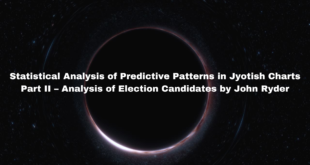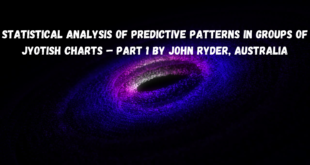Related Articles
Rishi Jaimini is emperor of brevity. He can speak volumes in one word. Horoscopic knowledge is as vast as ocean. Shri Jaimini had the capacity to condense all information about his Horoscopic thesis in one word.
He designed one such sutra which contained his tally of sutras chapter wise.
The opening sutra of the Jaimini granth is उपदेशं व्याख्यसामः. What is the significance of Upadesh?
It is tradition of every writer of yore to invoke blessings of their respective ISHT or preceptor in the first verse of their granthas. Maintaining that tradition, taking first sutra as benediction, expert commentators on Jaimini sutras have translated this sutra as benediction –
- U – pada – sham – bowing at the feet of Umapati Shankar we
explain Horoscopy for benefit of humanity or
- Invoking blessings of Goddess Parvati, this granth is initiated for good of mankind or
- O God let me place my work before readers for their knowledge etc.
We differ from such interpretations. In no way upadesh equates prayer. The simple meaning of word upadesh is teaching, instruction and lessons. What was the purpose of using upadesh by that master of terminology? Let us break this word into consonants and vowels and see the indications.
उ प दे श
उ , प् + अ , द् + ए , श् + अ
We get 3 letters and 4 vowels in this word. The ratio of letters and vowels is 3:4.
Draw a (box) rectangle with parallel lines in the ratio of 3:4 i.e.

This is the format of South Indian style of horoscope. It confirms that compilation relates to the 12 signs of the zodiac. Hence upadesh refers to science of horoscopy which is valid for (3) phases of time – Past, Present and Future and for (4) yugas – Satyayuga, Treta, Dwaper and Kaliyuga.
Again consonants (letters) प द श ( p_ ) ( d_ ) (sh _ )
Represent three chapters of the granth and four vowels उ अ ए अ ( – – – -) represent four sections in each chapter.
Place numerical value under KATAPAYA system for प द श ( p) (d) (sh), these are प ( p) = 1, द ( d) = 8, श (sh) = 5. When written in reverse order (or speaking order) figure that emerges is 581. This infact is the total number of sutras spread over three chapters of 4 sections each.
Whatever be the count of sutras in the FIRST chapter, if condensed into single digit the answer should be 5, similarly condensed digit for 2nd chapter should be 8 and that of third chapter should be 1. Example of a condensed figure – Let my year of birth be 1937 = 1+ 9 + 3 + 7 = 20. 2 + 0 = 2
So 1937 is condensed as 2.
Carefully count all the sutras of all four sections of chapter one (FIRST). The count is Section No. 1 34 sutras
No. 2 121 sutras
No. 3 44 sutras
No. 4 49 sutras
——————————
Total 248
Condensed digit is 2+4+8=14
1+4=5
Similarily section wise count of sutras of chapter 2 is = 60+33+31+37=161
1+6+1=8
Sutras in the missing chapter 3 can be worked out as under –
Total Sutras – 581
Less sutras of chapter I and chapter II (248+161=409) – 409 ———
172
The condensed digit for chapter 3 = 1+7+2=10
1 + 0=1
Thus chapter wise condensed digits match with (p) (d) (sh) प द श
(Note: Dr. P.S. Shastri researched the exact section wise number of sutras for chapters I and II)
Jaimini sutras in four chapters are available in the market. We doubt the authenticity of published version of chapters III and IV. Dr. Shastri has made the following comments on chapter III and IV.
“The problem is more complicated with regard III and IV. The available texts are corrupt at many places, some of these sutras repeat what has already been stated in chapter I and II and few sutras reproduced verbatim”
It appears that chapters III and IV were added by someone in the name of Jaimini. The Rishi is averse to any sort of repetitions, Not to speak of repetition, Rishi would economize even on the use of a vowel without a purpose, and as such he cannot be the author of chapter III and IV. He would never allow such a thing to happen to his text. It ought to be a foreign material. This leads us to conclude that third chapter is yet to be discovered. It is very likely that missing third chapter might be dealing with results of various dashas and antardashas in details giving formulas as to how to select a particular dasha for a given horoscope which is still a mystery to the students of Jaimini.
The following further interpretations can be placed on digits 5, 8 and 1.
5 stands for 5 sidhantas not available in any other system of horoscopy viz –
- Signs aspect each other
- Forward and backward count of bhavas
- Planets have no independent aspect, they borrow aspect pattern of bhava where it is placed.
- Degree based moveable karakas.
- Nakshatra have no place in the system.
- (i) 8 stands for eight planets which participate in movable karaks
(ii) 8 lagnas help in prediction e.g. Karakamsha lagna, Arudha lagna, Kaalghati lagna, Upapada lagna, Pitree lagna, Kaal Hora lagna, Kaal Ghati lagna, Drekkana and Navamsha lagna. Janam lagna is not a predictive tool.
- 1 stands for TRUTH and single picture of future for a native through Jaimini system.
Digits 5, 8, 1 have many spiritual and corporal significances. उदेश
Udesh is a code for Jaimini sutras.
Learn Astrology: Join Our Upcoming Astrology Classes — Click Here
Learn Astrology: Join Our Recorded Astrology Classes — Click Here
 Saptarishis Astrology Magazine Into Creating Astrologers
Saptarishis Astrology Magazine Into Creating Astrologers






